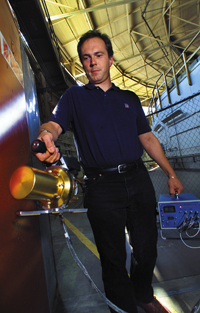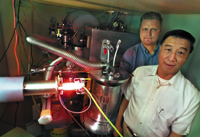|
One solution is a 10-pound, battery-powered detector that
promises to bring state-of-the-art radiation spectrometry
anywhere radioactive materials might be found. The device,
called Cryo3, was developed in collaboration with researchers
at Lawrence Livermore National Laboratory. At the heart of
the unit is a high purity germanium crystal. The crystal absorbs
energetic photons emanating from isotopes and creates a corresponding
charge. When further processed, this charge depicts both the
quantity and type of radioactive material present.
|
|
 |
 |
| |
|
| |
Lorenzo Fabris, of Berkeley
Lab's Engineering Division, holds the Cryo3, a highly
sensitive, portable radiation detector. |
|
|
The need for such devices is underscored by the sobering
fact that isotopes can be used to build conventional bombs
laden with radioactive material -- so-called dirty bombs.
Furthermore, contraband isotopes can be hidden in backpacks
and car trunks, which means that airports, border checkpoints,
and shipping terminals provide the last best chance to thwart
smuggling.
To complicate matters, any tool used to screen for isotopes
in busy terminals must detect not only the presence of radiation,
but also the type. A terrorist could mask radioactive material
destined for a dirty bomb in a seemingly benign package of
medical isotopes, and therefore sneak past a Geiger counter.
Fortunately, germanium-based detectors characterize radiation
type. They also offer higher radiation resolution than other
semiconductors such as silicon and cadmium telluride. But
there's one problem. The element must be deeply cooled with
liquid nitrogen. And although liquid nitrogen is very common
in the laboratory, it is awkward to transport and handle in
the field.
To sidestep this limitation, Berkeley Lab engineers coupled
the germanium crystal to an off-the-shelf mechanical cooling
device currently used to cool low-noise cell phone antennae.
The device requires only 15 watts to cool the germanium to
87 degrees Kelvin. When the cryogenic mechanical cooler is
vacuum sealed to a germanium detector, the result is a lightweight,
highly sensitive radiation detector that operates up to six
hours on two rechargeable camcorder batteries.
"The innovation is coupling a germanium radiation detector
with a small, low-power cryogenic cooling mechanism,"
says Lorenzo Fabris of the Engineering Division. "This
offers extremely high-resolution radiation analysis in a portable
package."
Ultimately, Fabris foresees a time when next-generation iterations
of Cryo3 safeguard the nation with lab-quality, portable radiation
detection and characterization.
"Whatever you can detect with a germanium crystal, you
can detect with the portable system," says Fabris. "Ideally,
we would be able to place one at any customs port."
Seeing the Unseen
Another Berkeley Lab team has developed a portable device
that uses neutrons to peer inside luggage and shipping containers
to determine if explosive and fissile materials lurk inside.
|
|
 |
 |
| |
|
| |
Ka-Ngo Leung (right) and
Jani Reijonenl, both from the Accelerator and Fusion Research
Division, stand beside the compact neutron generator.
|
|
|
The device, developed by Ka-Ngo Leung and his colleagues
in the Accelerator and Fusion Research Division, represents
a marked improvement over commercial compact neutron generators,
which are typically expensive and short-lived. The tiny, tube-shaped
generator costs roughly $80,000 -- that's $20,000 cheaper
than generators of comparable capacity. It has also shown
promise as a portable screening tool.
"We use different energies of neutrons to penetrate
different materials such as steel and aluminum," says
Ka-Ngo Leung. "We are currently testing how much luggage
can be interrogated at a time, and how long it takes to examine
a container."
In general, neutron generators fire an ionized gas composed
of hydrogen isotopes, either deuterium or tritium ions, at
a metal target that also contains deuterium or tritium. The
ions fuse with their counterparts in the target plate in a
process that emits neutrons. These neutrons are then directed
toward a structure that researchers want to examine--anything
from brain tissue to crystals to luggage. The neutrons and
gamma rays that bounce back are used to elucidate the internal
makeup of the structure.
Unfortunately, today's compact generators have several drawbacks.
Once the deuterium or tritium in the target plate is depleted,
the generator no longer works. In addition, most neutron generators
use an ion beam that is largely composed of two or three-atom
molecules, which are less likely to produce neutrons in fusion
reactions than single atoms. Perhaps most troublesome, today's
portable neutron generators rely on deuterium-on-tritium reactions,
which produce more neutrons than deuterium-on-deuterium reactions.
However, any process that uses the unstable element tritium
is burdened with layers of transport and safety concerns --not
an ideal characteristic for a generator that may eventually
be placed in airports and at customs checkpoints.
Berkeley Lab's portable neutron generator tackles these problems
head-on. First, the target plate no longer contains deuterium
or tritium ions. Instead, a thin sheet of titanium and copper
pitted with water-cooling channels is used. The deuterium
or tritium beam hits the target and continually adds new ions
to the plate. This means the target cannot be depleted.
Second, the team increased the number of single atoms in
the ion beam. Ninety percent of the ion beam is composed of
single atoms, compared to 20 percent in beams produced by
commercial generators.
"The beam is composed of single atoms instead of molecules.
This emits more neutrons at the same energy," explains
Jani Reijonenl, also with the Accelerator and Fusion Research
Division. "This means we can use it in the field at powers
only offered by much larger, lab-based generators."
Finally, the Berkeley neutron generator is engineered to
rely on deuterium-on-deuterium reactions without decreasing
the number of neutrons produced. The team accomplished this
by using a cylindrical target instead of a two-dimensional
plate. The rod-shaped ion source, which nests inside the cylinder,
emits ions along its entire length. These ions strike the
target that envelops it, a process that produces tens of trillions
of neutrons per second.
"We can use deuterium reactions, which are much easier,
cheaper, more field-ready than reactions involving tritium,"
says Ka-Ngo Leung. "With these developments, we are striving
to make the generator as efficient as possible."
-- Dan Krotz
|



